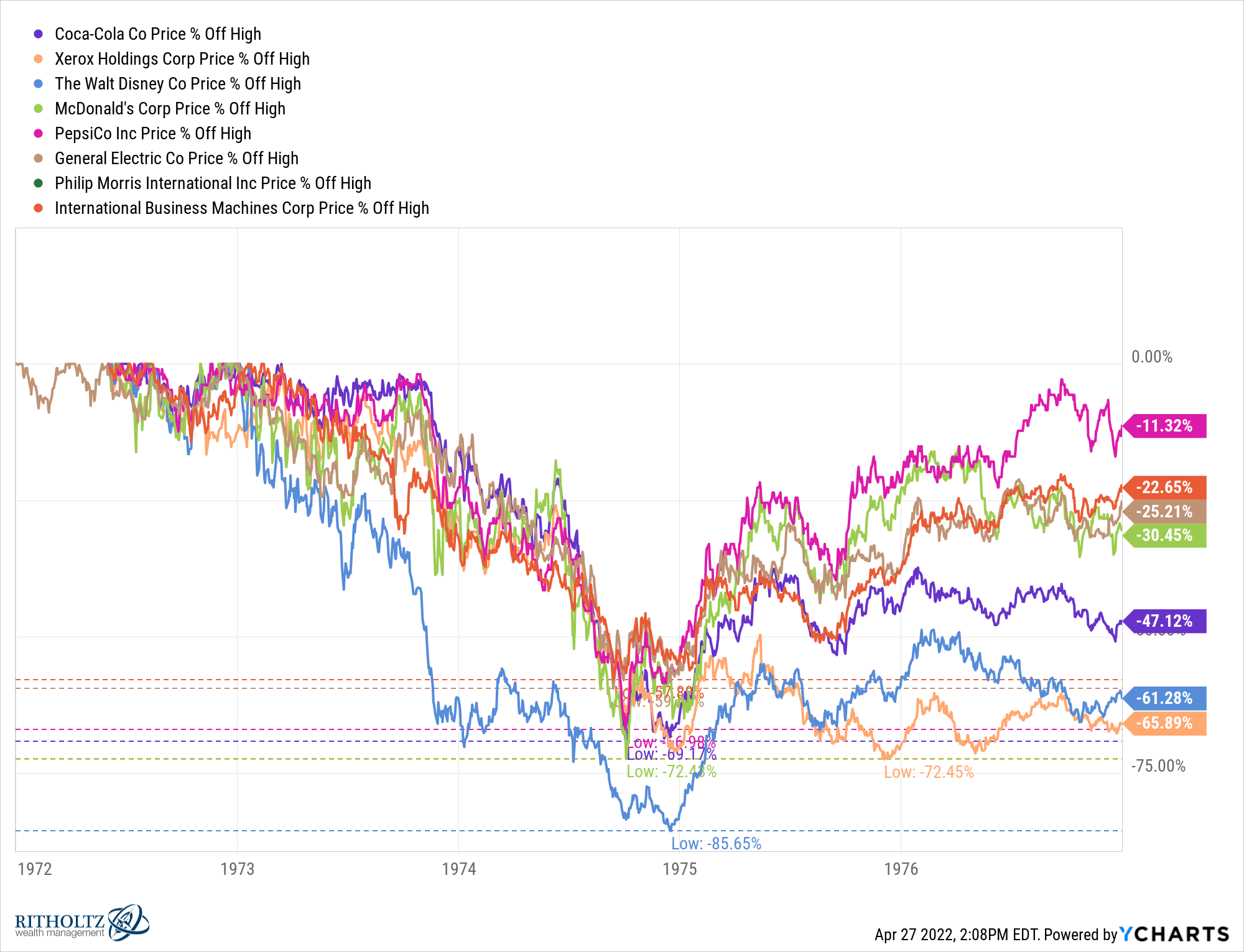A reader asks:
As the NASDAQ has had a rough start to 2022, and high multiple names have been crushed, and the street view seems to be that Cathie Wood stocks are essentially going to keep crashing with rates/inflation being what they are. I wanted to see if there was a contrarian take – if one has a 5yr or a 10yr horizon, would these innovation/technology plays not be the perfect companies to have in a portfolio? Should one not be buying slowly into these names as the prices keep dropping?
It’s getting brutal out there.
The Nasdaq Composite entered bear market again this week, down as much as 22% from all-time highs. This index has more than 4,700 stocks in it:
- 61% are down 20% or worse
- 43% are down 40% or worse
- 29% are down 60% or worse
Cathie Wood’s ARKK fund is now 68% off its all-time highs from February 2021.
Growth stocks had an amazing run there for a while but many household names are now getting obliterated.
You have companies like Zoom (-82%), Netflix (-71%), Peloton (-89%), Facebook (-46%), Shopify (-74%), Square, (-63%) and Spotify (-71%) with massive drawdowns from their peaks.
Not great.
To be fair, these losses need to be put into perspective. The gains leading up to this slaughter were gigantic.
These are the annual returns for the Nasdaq since the Great Financial Crisis ended:
- 2009: +45.3%
- 2010: +18.0%
- 2011: -0.8%
- 2012: +17.9%
- 2013: +40.9%
- 2014: +14.7%
- 2015: +7.0%
- 2016: +8.9%
- 2017: +29.6%
- 2018: -2.8%
- 2019: +36.7%
- 2020: +44.9%
- 2021: +22.2%
For those of you scoring at home, that’s returns of more than 20% per year for 13 years!
You can’t expect that kind of run to last forever. There were some drawdowns along the way but nothing like the current crash in many of the public’s most beloved stocks of the past few years.
And the gains in many of those individual stocks were even crazier than the Nasdaq itself.
From the bottom in March 2020, Zoom was up more than 250% in just 7 months. Spotify gained more than 200%. Peloton was up more than 600% in less than 9 months. Square rose 600% off the lows as well.
From 2019 through November 2021, Shopify was up a ridiculous 1,100%. From its IPO in 2012 through the all-time highs in September 2021, Facebook compounded at nearly 30% per year. From 2014 through November 2021, Netflix gave investors almost 40% per year.
I’m sorry but you don’t get returns like that without a crash on the other side at some point. This is how risk and return work.
In many ways, this current run-up and subsequent crash in growth stocks are similar to the Nifty Fifty stocks of the 1970s.
Stocks like Polaroid, Coca-Cola, IBM, Xerox and McDonald’s became the darlings of both institutional and retail investors alike in the early 1970s. They had proven track records for growth and became one decision stocks — and that decision was to buy.
Expectations got so out of whack with reality that the valuations on these stocks went vertical. It wasn’t unheard of for these stocks to trade at anywhere from 50-100x earnings.
Once a bear market hit in the mid-1970s, these stocks got massacred:

We’re talking about losses of anywhere from 55% to 90% on these blue-chip growth stocks. Polaroid dropped more than 90% while Avon was down more than 85%.
The technology sector was much smaller back then but ended up underperforming the market for nearly 3 decades from the height of the Nifty Fifty craze.
Interestingly enough, many of these stocks ended up being great investments over the long-term.
From 1971 to the present day, McDonald’s is up almost 15% per year. Pepsi is up nearly 12% annually.
But some of them haven’t been so lucky. GE and IBM have both underperformed the market since the 1970s. Then you have companies like Polaroid or Sears that are no longer public companies.
Picking the winners is hard.
I like that this reader is thinking about holding these stocks for the long-term. That should help but it doesn’t guarantee success.
And even if some of these companies end up becoming good investments over the long run, they could still crush you in the short run.
For instance, Teladoc, the virtual health provider that seemed like a no-brainer once the pandemic hit was down 82% from all-time highs heading into the company’s earnings release on Wednesday after the close.
The stock dropped almost 40% from those levels following a worse than expected report.
Catching a falling knife is never easy but here are some questions you should ask yourself when trying to pick up bargains from the growth stock bin:
- What is my time horizon?
- Am I willing to put more money in at these depressed prices?
- How will I react if the stock falls further?
- How will I know if I’m wrong?
These are not easy questions to answer but investing is not supposed to be easy.
There are going to be a handful of growth stocks that people are going to look back on in 5,10, maybe 15 years that look like fantastic buys at the moment.
But there are also going to be those stocks that never reach their 2021 peaks again.
Investing is always easier with the benefit of hindsight. These things are never that easy in the moment.
We discussed this question on Portfolio Rescue this week:
Brian Feroldi joined me to discuss growth stocks, dollar cost averaging and why stocks go up.
Further Reading:
The Nifty Fifty and the Old Normal
